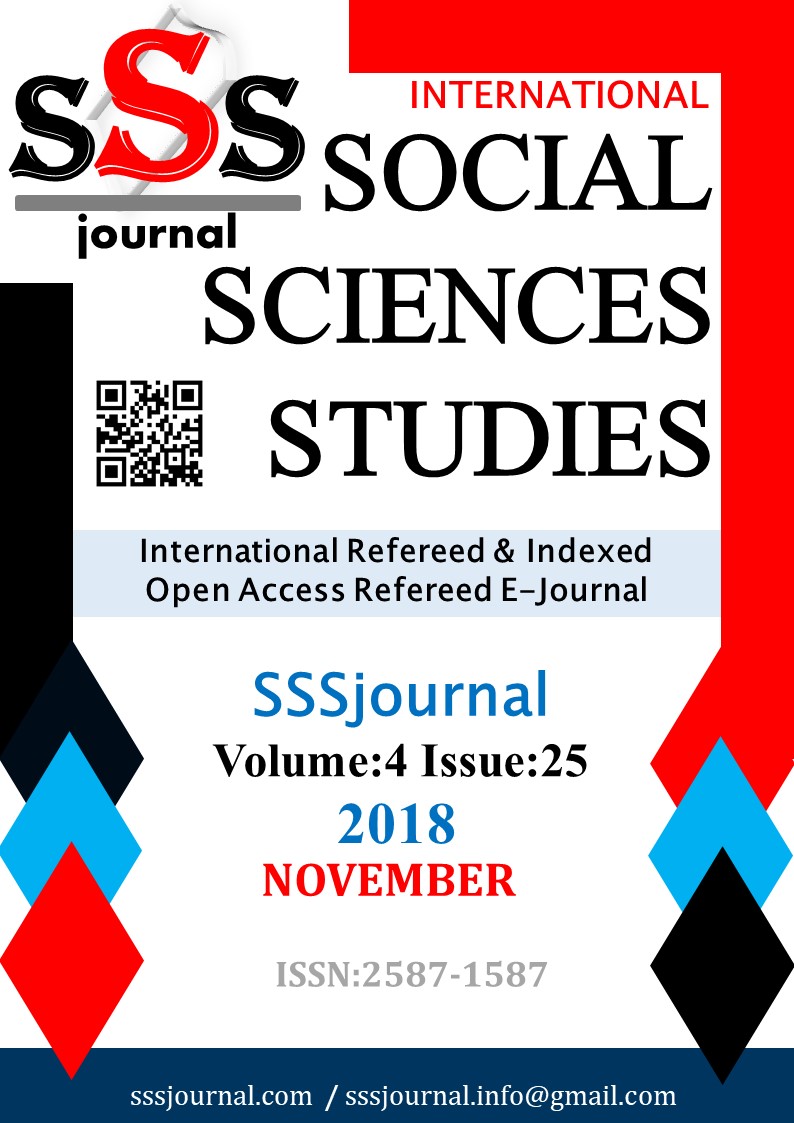Author :
Abstract
Girişimci ve inovasyonel yönetim konuları, son dönemlerde gerek araştırmacıların gerekse politikacı ve bürokratların ilgi odağı haline gelmiştir. İnovasyonun ortaya koyduğu değişiklikler, hem ulusal kurumlar, hem uluslararası yönetimler bazında karşılaştırmalar yapılarak incelenmiştir. Araştırmacıların birçoğu inovasyonun kamu hizmetlerinin kalitesinin artırılmasına ve problemlerin çözümüne katkı sağlamasının yanı sıra, kamu kurumlarının toplumsal zorluklarla başa çıkma kapasitesini arttıracağı konusunda hemfikirdirler. Kamu kurumlarında girişimci ve inovasyonel yönetim anlayışının uygulanması ve geliştirilmesi, her şeyden önce kamu çalışanlarının girişimcilik yeteneğine sahip olmalarıyla birlikte inovasyonu kabul etmeleri, bu konudaki istekliliği ve inovasyon algı seviyesinin yüksek olmasına bağlıdır. Bu çalışmada, merkezdeki bürokratik kurumların yönetim kademelerinde görev yapan alt-orta ve üst düzey yöneticilerin yenikçi (inovatif) yönetim anlayışına yönelik algı düzeyleri ölçülmeye çalışılmıştır. Özellikle, Bakanlık teşkilatlarında görev yapan 286 yöneticiye anket uygulanmış ve yöneticilerin inovasyonla ilgili davranış tarzları dört temel faktör çerçevesinde Anova ve Faktör Analizi yöntemleri ile analiz edilerek yöneticilerin yenilikçilik algısı belirlenmeye çalışılmıştır.
Keywords
Abstract
In recent times, entrepreneurial and innovative management issues have become the focus of attention of both researchers and politicians and bureaucrats. The changes made by innovation are examined by making comparisons on the basis of both national institutions and international administrations. Many researchers agree that innovation will contribute to improving the quality of public services and solving problems, as well as increasing public institutions' capacity to cope with social challenges. The implementation and development of the entrepreneurial and innovative management approach in public institutions depends primarily on the acceptance of innovation by public employees as well as the entrepreneurial ability, the willingness to do so and the high level of innovation perception. In this study, it is tried to measure the perception levels of sub-middle and high level managers who work in the management levels of the bureaucratic institutions in the center. In particular, 286 executives working in the ministerial offices were surveyed. and managers' behavioral behaviors were analyzed with Anova and Factor Analysis methods within the framework of four main factors and the perception of managers about innovation was tried to be determined.
Keywords
- Alves, H. (2013). “Co-Creation and Innovation in Public Services”, The Service Industries Journal, Vol 33,
- Alves, H. (2013). “Co-Creation and Innovation in Public Services”, The Service Industries Journal, Vol 33, No 7-8, ss.671-682.
- Anttiroiko, Ari-Veikko, Stephen J. Bailey and Pekka Valkama (2011). “Innovations in Public Governance inthe Western World”, Innovations in Public Governance, Editors: Ari-Veikko Anttiroiko, Stephen J. Bailey and Pekka Valkama, IOS Press, Amsterdam, ss.1-22.
- Ateş, H.820019, “Isletmecı, Gırısımcı ve Verımlı Yenı Bır Kamu Yönetımı ve Devlet Anlayısına Dogru”, I.Ü.Siyasal Bilgiler Fakültesi Dergisi, No: 25, Ekim, ss.45-59.
- Bartlett, D. and Dibben, P. (2002). “Public Sector Innovation and Entrepreneurship: Case Studies from Local Government”, Local Government Studies, Vol 28, No 4, ss.107-121.
- Bjerke, B. (2007), Understanding Entrepreneurship, Edward Elgar Publishing Limited, Cheltenham, UK • Northampton, MA, USA.
- Cochran, J. P. (2014), Assessing the Relationship between Leadership and Innovation in the Public Sector, Doktorate Thesis, Published by ProQuest LLC, Arizona.
- Drucker, P. F. (2002), Innovatıon And Entrepreneurshıp Practice and Principles, Harpercollins Publisher Inc., November.
- Drüke, H. (2011), “Networked Public Administration for Better Service: New Production Model for Local
- Service Delivery in Germany”, Innovations in Public Governance, Editors: Ari-Veikko Anttiroiko, Stephen J. Bailey and Pekka Valkama, IOS Press, Amsterdam, 2011, ss. 140-152.
- Jäppinen, T, (2011), “New User-driven Innovation Policy: The Key to Finnish Local Government ServiceReform”, Innovations in Public Governance, Editors: Ari-Veikko Anttiroiko, Stephen J. Bailey and Pekka Valkama, IOS Press, Amsterdam, ss. 158-173.
- Jordan, S. R. (2014). “The Innovation Imperative: An Analysis of The Ethics of The Imperative to Innovate in Public Sector Service Delivery”, Public Management Review, Vol 16, No 1, ss. 68-83.
- Koch, P. and Hauknes, J. (2005), Innovation in the Public Sector: On İnnovation İn The Public Sector-TodayAnd Beyond, Publin Report No. D20, NIFU STEP Studies in Innovation, Research and Education, Oslo.
- Luke, B., Verreynne, M.L. and Kearins, K. (2010).” Innovative and Entrepreneurial Activity in The PublicSector: The Changing Face of Public Sector Institutions”, Innovation: Management, Policy and Practice, Vol 12, No 2,ss.138-153.
- Moore, M. and Hartley, J. (2008). “Innovations in Governance”, Public Management Review, Vol 10, No 1, ss.3-20.
- Öztürk, A.O. (Ekim 2012). “Kamu Örgütlerinde Girişimcilik”, İş Güç” Endüstri İlişkileri ve İnsan Kaynakları Dergisi, Cilt 14, Sayı 4, ss.153-169.
- Potts, J. and Kastelle, T. (2010). “Public Sector Innovation Research: What’s Next?”, Innovation: Management, Policy and Practice, Vol 12, No 2, ss.122-137
- Taşgit,Y. E.- Torun, B. (2016), “Yöneticilerin İnovasyon Algısı, İnovasyon Sürecini Yönetme Tarzı veİşletmelerin İnovasyon Performansı Arasındaki İlişkiler: KOBİ’ler üzerinde Bir Araştırma”, Yönetim Bilimleri Dergisi, Cilt .14, Sayı 28, ss. 121-156,
- Torugsa, N. A. & Arundel, A. (2014): “Complexity of Innovation in The Public Sector: A Workgroup-LevelAnalysis of Related Factors and Outcomes”, Public Management Review, Published online (http://dx.doi.org/10.1080/14719037.2014.984626), s.7.
- Veenswijk, M. (Ed.), (2005), Organizing Innovation: New Approaches to Cultural Change and Intervention in Public Sector Organizations, IOS Press, Amsterdam-The Netherlands.
- Vries, H.- Bekkers, V. & Tummers, L. (2014), “Innovation in the Public Sector: A Systematic Review and Future Research Agenda” Speyer: EGPA conference.
- Wegener, C. and Tanggaard, L.(2013). “The Concept of Innovation As Perceived By Public Sector FrontlineStaff: Outline of A Tripartite Empirical Model of Innovation”, Studies in Continuing Education, Vol 35, No 1, ss.82-101.
- Walker, R. M. (2014). “Internal and external antecedents of process innovation: A review and extension”, Public Management Review, 16(1), 21-44.
- Walker, R.M. (2006). “Innovation Type and Diffusion: An Empirical Analysis of Local Government”, Public Administration, 84, 2, 311–35.
- Walker, R. M. (2003). “Evidence on the Management of Public Services Innovation”, PublicMoney & Management, Vol 23, No 2, pp.93-102.
- Yapp, C. (2005). “Innovation, Futures Thinking and Leadership”, Public Money and Management, Vol 25, No 1, ss.57-69.
